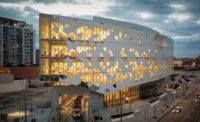Craig Dykers, a founding partner of Snøhetta, jokes that his firm and the Canadian practice Dialog won the competition for the New Central Library (NCL) in Calgary, Alberta, by “cheating.” Well, not cheating exactly, but by bending the rules. Rather than consider the designated site as a given, they shifted it slightly to include a piece of land that was not part of the original design brief. With the adjusted parcel, the architects devised a stretched-out volume with a prow-like northern end and a series of interior vantage points ideal for observing the activity of the city below. “It’s about creating connections to the street,” says Dykers.
Starting today, when the $245-million (CAD), 240,000-square-foot NCL officially opens in the developing East Village neighborhood adjacent to the downtown core, patrons can watch from these corner vantage points as trains leave from a nearby light-rail station and disappear underneath the building. Incorporating this line was a key competition requirement, and the Snøhetta-Dialog scheme takes full advantage: a reinforced concrete podium encloses the train tunnel, while the curved four-story concrete-and-steel superstructure that emerges from this base takes its cues from the arc of the tracks.
The library is clad in 465 hexagonal panels of glass and metal. Their shape helps “negotiate” the radius of the facade without obvious faceting, explains Rob Adamson, a Dialog principal. People enter through an elongated, arched opening carved out of this skin that defines a public exterior passageway extending from one side of the building to the other. Overhead, cedar planks reinforce the shape of the arch, which the architects say was inspired by the Chinook winds—a cloud formation that occurs in the region under certain weather conditions.
Inside, the wood continues, though with different species. White oak is on much of the floor area, while Western Hemlock is used extensively on vertical surfaces—especially the balustrades surrounding a skylit atrium that runs the full height of the library. The hexagonal motif of the facade also comes indoors. It can be seen in various places, including the ceramic tiles in the bathrooms and on the backs of the vests that staff members wear. “People want an identity for their library,” says Dykers. And he clearly has provided a very effective one. The pattern was recently adopted as the logo, not only for the NCL, but for the city’s entire library system.
Stay tuned for expanded coverage of Calgary’s New Central Library in print and online.










